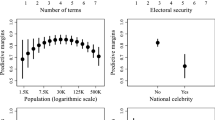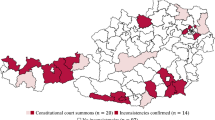Abstract
In many American states, municipal annexation and consolidation require concurrent majority votes of all affected jurisdictions. The effectiveness and fairness of this voting procedure have been criticized on the grounds that a small minority of voters can frustrate the preferences of the overall majority. This paper investigates the extent to which the relative ability of voters in large and small jurisdictions to influence voting outcomes in procedures requiring concurrent majorities is influenced by jurisdictional size. The Banzhaf index, which counts the number of case4s in which a given voter could reverse the overall group decision by changing positions on an issue, is applied to this problem of concurrent voting majorities. Mathematical analysis indicates that the ratio of power between voters in small and large jurisdictions approximately equals the inverse of the square root of the ratio of their population size.
Similar content being viewed by others
References
Banzhaf, J.F., III (1965), “Weighted Voting Doesn't Work: A Mathematical Analysis,” Rutgers Law Review, 19, pp. 317–343.
Banzhaf, J.F., III (1966), “Multi-Member District-Do They Violate the One Man, One Vote Principle?” Yale Law Journal, 75, pp. 1309–1338.
Banzhaf, J.F., III (1968), “One Man, 3.312 Votes: A Mathematical Analysis of the Electoral College,” Villanova Law Review, 13, pp. 304–332.
Grofman, B., and H. Scarrow (1981), “Weighted Voting in New York,” Legislative Studies Quarterly, 6, pp. 287–304.
Hagman, D.G., and S.G. Disco (1970), “One Man One Vote as a Constitutional Imperative for Needed Reform of Incorporation and Boundary Change Laws,” Urban Lawyer, 2, pp. 458–470.
Hinton, J.F., Jr., and G.M. Walker (1977), “Municipal Annexation: An Urban Dilemma,” Alabama Law Review, 28, pp. 717–745.
Imrie, R.W. (1973), “The Impact of the Weighted Vote on Representation in Municipal Governing Bodies of New York State,” Annals, New York Academy of Sciences, 219, pp. 192–199.
Johnson, R.E. (1969), “An Analysis of Weighted Voting as Used in Reapportionment of County Governments in New York State,” Albany Law Review, 34, pp. 1–45.
Lipsig, E.B. (1973), “Annexation Elections and the Right to Vote,” UCLA Law Review, 20, pp. 1093–1128.
Longley, L.D., and J.D. Dana, Jr. (1984). “New Empirical Estimates of the Biases of the Electoral College for the 1980's,” Western Political Quarterly, 37, pp. 157–175.
Owen, G. (1975), “Evaluation of a Presidential Election Game,” American Political Science Review, 69, pp. 947–953.
Author information
Authors and Affiliations
Rights and permissions
About this article
Cite this article
Shelley, F.M. Voting power in municipal annexation elections. Qual Quant 20, 257–260 (1986). https://doi.org/10.1007/BF00227429
Issue Date:
DOI: https://doi.org/10.1007/BF00227429




